Abstract
Captopril is a potent hypotensive agent whose efficacy has hitherto been attributed to its ability to alter either angiotensin II formation or kinin degradation. Our purpose was to examine captopril's acute effect on prostaglandin production, because changes in neither the renin-angiotensin nor the kallikrein-kinin systems appear adequate to account for the fall in arterial pressure. The plasma levels of angiotensin II, kinins, and prostaglandins were determined in response to increasing doses (5, 12.5, and 25 mg) of captopril and these responses were compared with the change in arterial pressure observed in nine supine normal male subjects studied on both a high (200 meq) and low (10 meq) sodium intake.
Captopril significantly (P < 0.01) increased the levels of the 13,14-dihydro-15-keto metabolite of prostaglandin E2 (PGE2-M), a potent vasodilator, with similar responses being observed on both a high and a low sodium intake. No significant changes in the plasma levels of 6-keto-prostaglandin F 1α, or thromboxane B2, the stable products of prostacyclin and thromboxane A2, respectively, occurred.
The depressor response to captopril correlated with the change in PGE2-M (r = 0.52, t = 5.44, P < 0.0001). On the other hand, although significant (P < 0.02) decrements in angiotensin II and increments in plasma kinins accompanied the hypotensive response in sodium-restricted subjects, in sodium-loaded subjects where the renin-angiotensin system was suppressed, no change in angiotensin II, and only a modest change in kinins was noted, even though significant (P < 0.01) decrements in diastolic blood pressure occurred (−10±2 mm Hg).
Thus, changes in depressor prostaglandin production can better account for the hypotensive response to captopril, thereby extending to yet another vasoactive system an influence by this class of drugs and providing a new approach to dissecting the abnormality in the control of vascular tone in patients with hypertension.
Full text
PDF
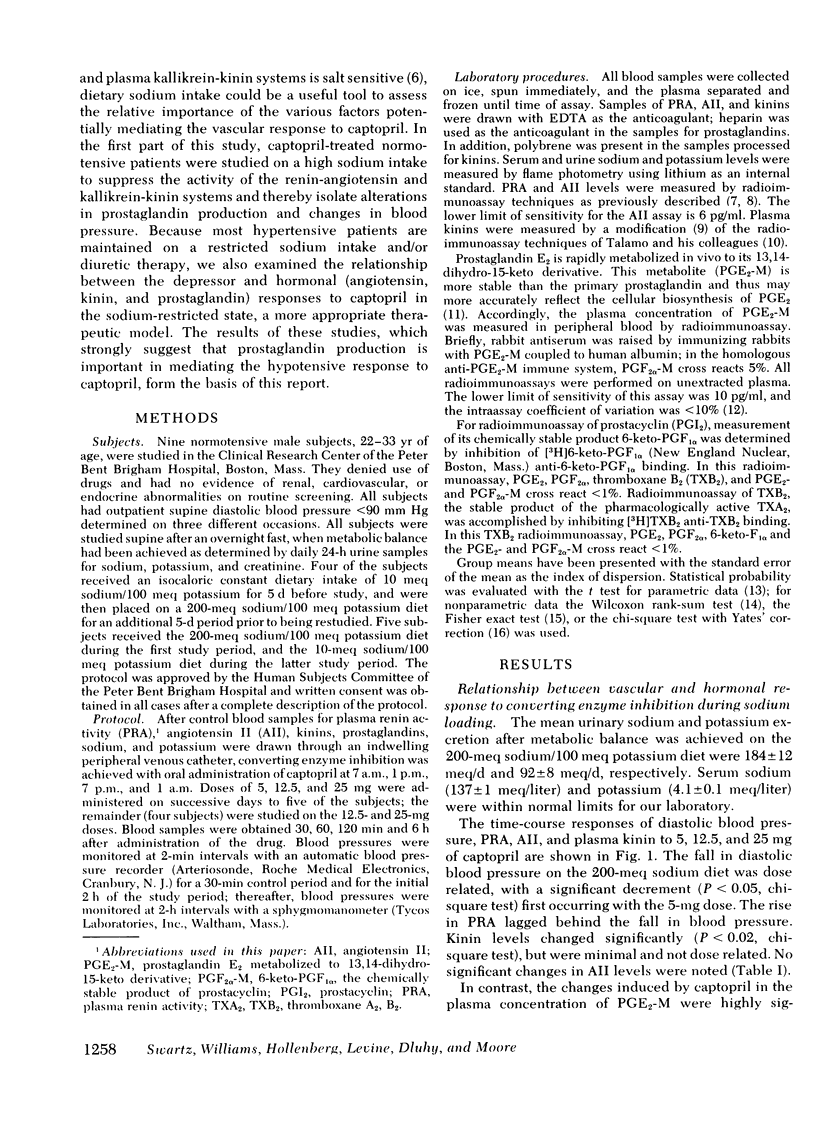
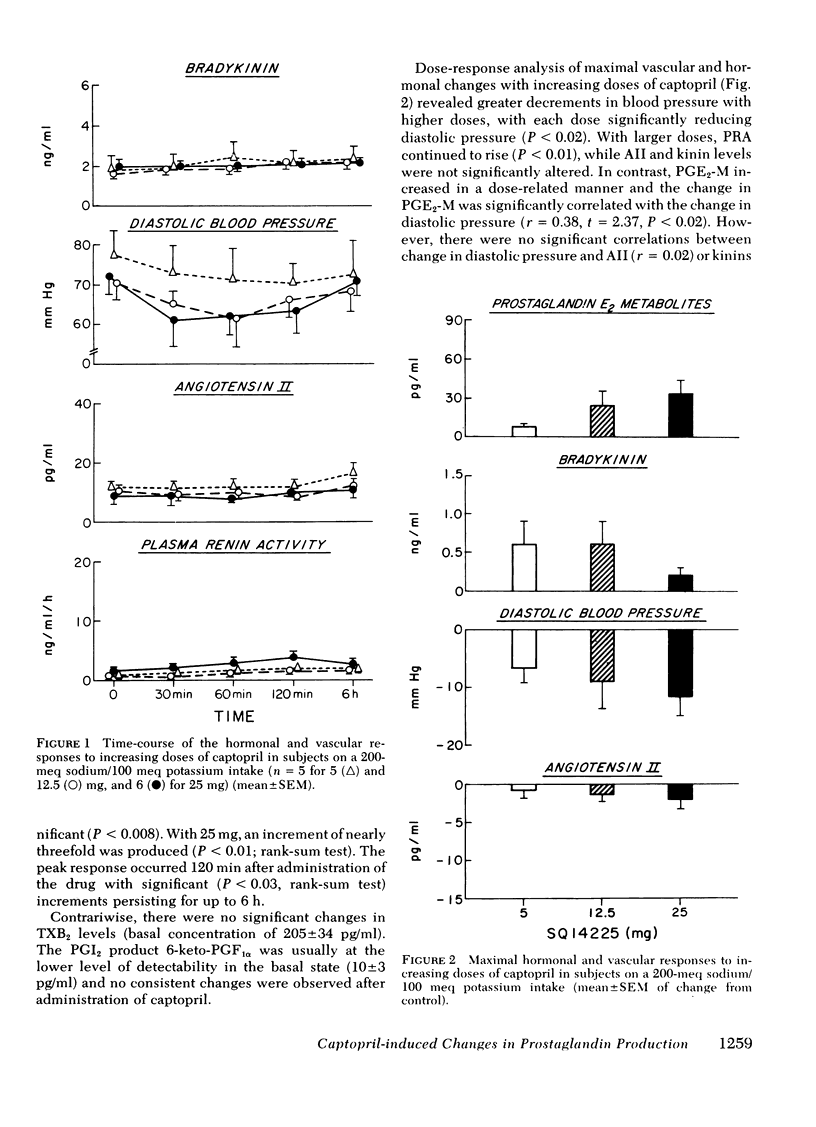
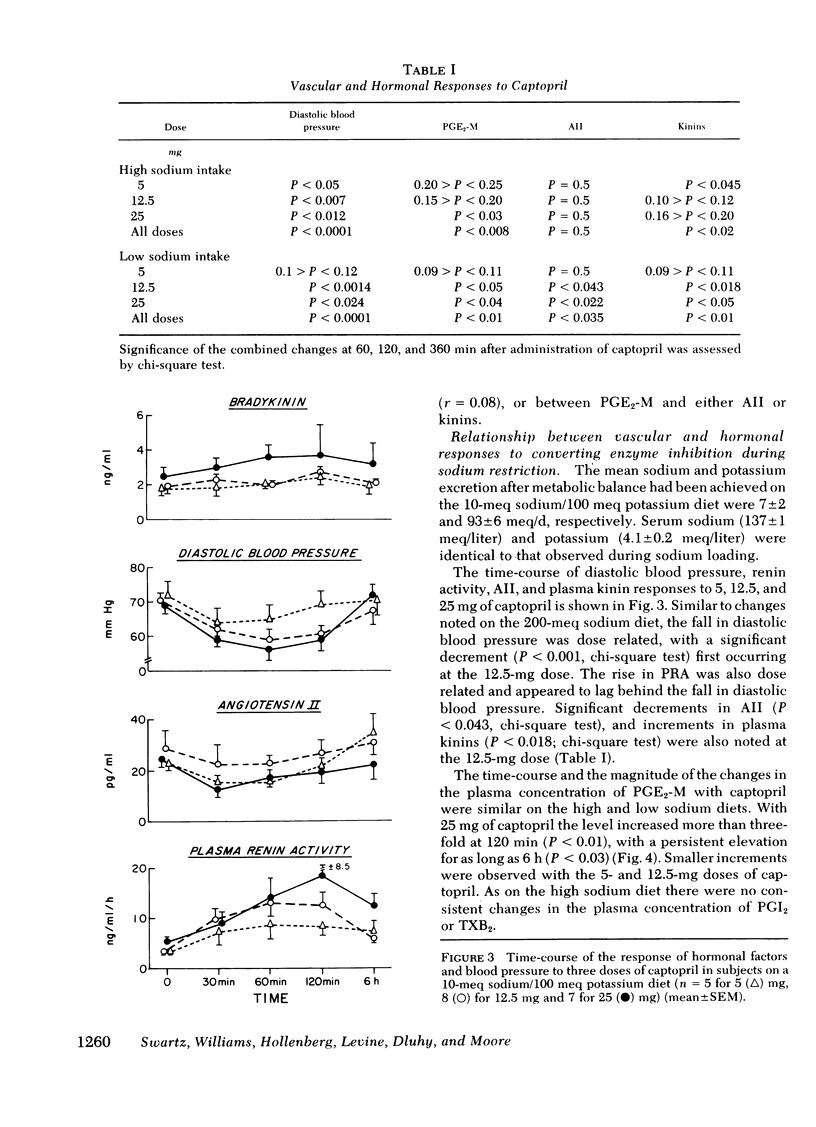
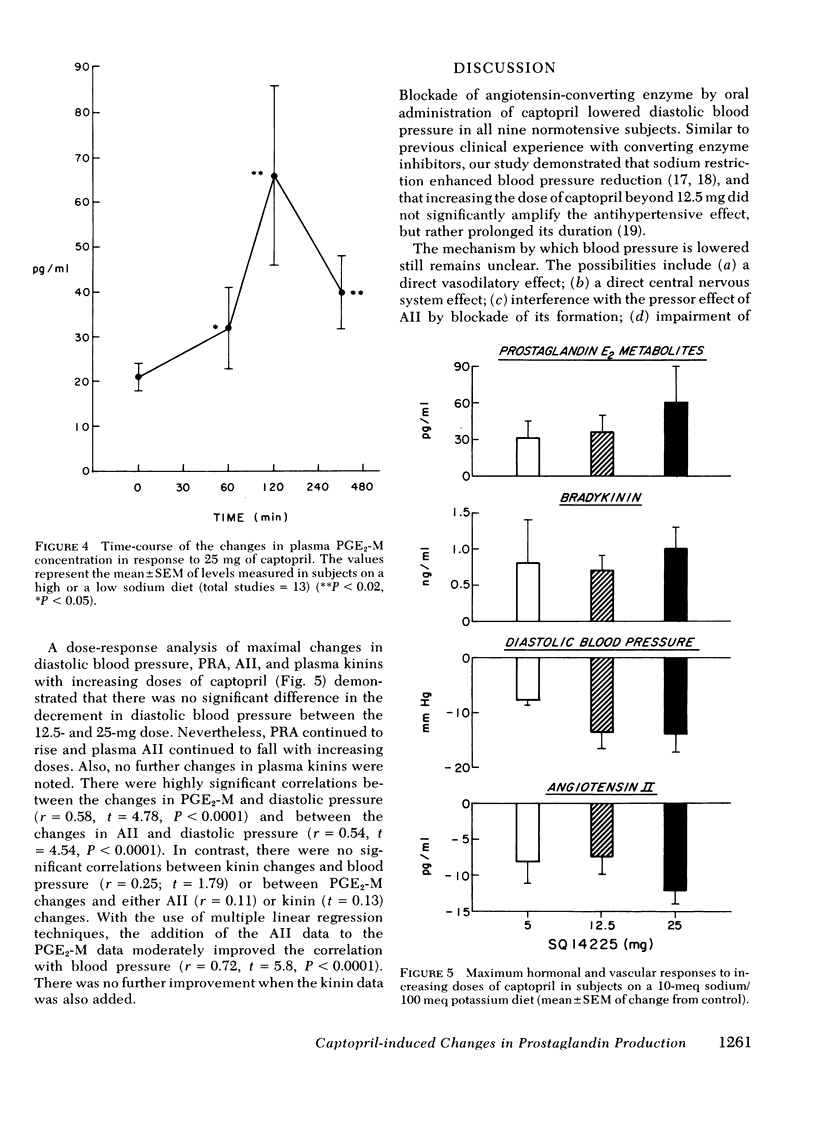
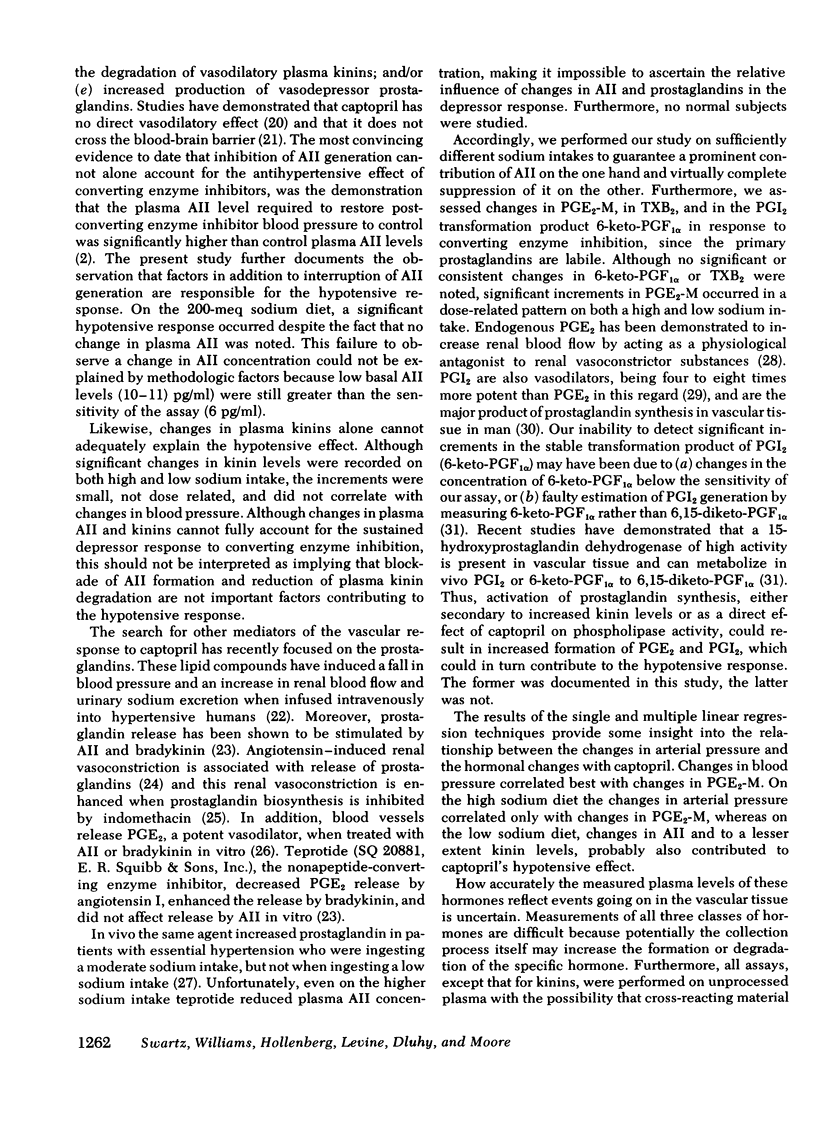
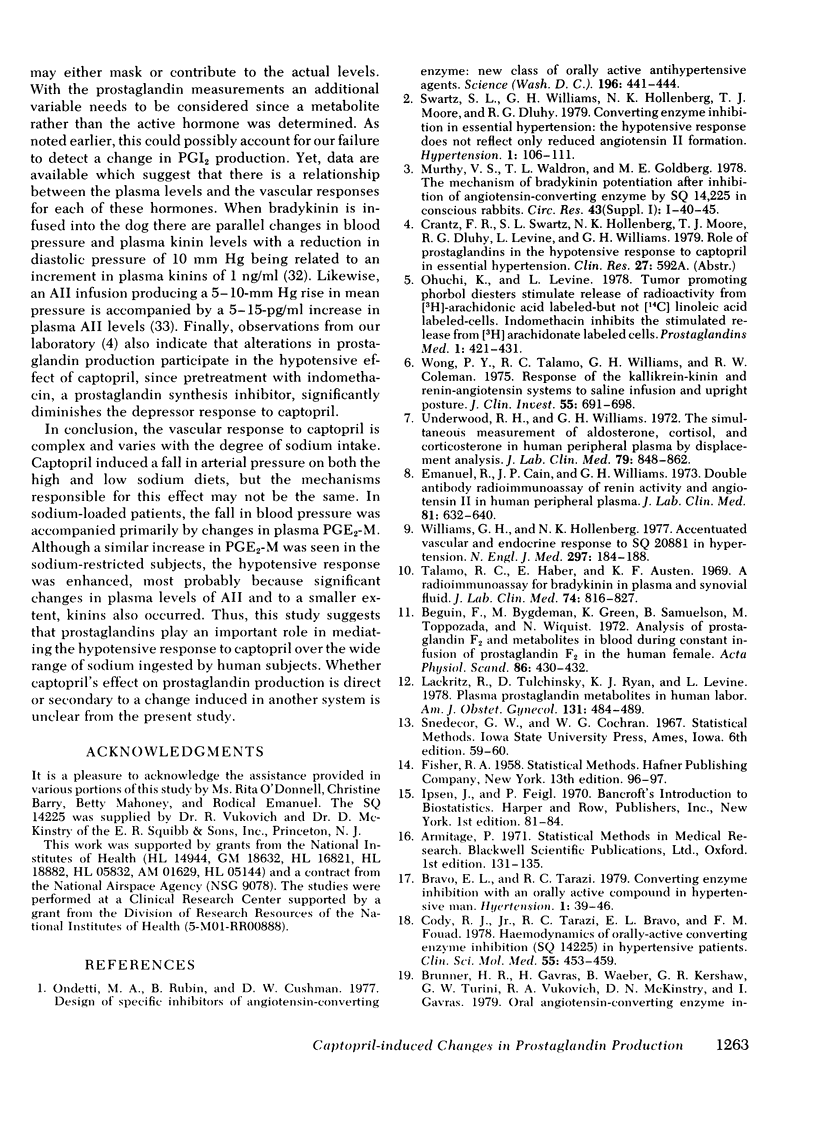

Selected References
These references are in PubMed. This may not be the complete list of references from this article.
- Aiken J. W., Vane J. R. Intrarenal prostaglandin release attenuates the renal vasoconstrictor activity of angiotensin. J Pharmacol Exp Ther. 1973 Mar;184(3):678–687. [PubMed] [Google Scholar]
- Armstrong J. M., Lattimer N., Moncada S., Vane J. R. Comparison of the vasodepressor effects of prostacyclin and 6-oxo-prostaglandin F1alpha with those of prostaglandin E2 in rats and rabbits. Br J Pharmacol. 1978 Jan;62(1):125–130. doi: 10.1111/j.1476-5381.1978.tb07014.x. [DOI] [PMC free article] [PubMed] [Google Scholar]
- Beguin F., Bygdeman M., Gréen K., Samuelsson B., Toppozada M., Wiqvist N. Analysis of prostaglandin F 2 and metabolites in blood during constant intravenous infusion of prostaglandin F 2 in the human female. Acta Physiol Scand. 1972 Nov;86(3):430–432. doi: 10.1111/j.1748-1716.1972.tb05349.x. [DOI] [PubMed] [Google Scholar]
- Blumberg A. L., Denny S. E., Marshall G. R., Needleman P. Blood vessel-hormone interactions: angiotensin, bradykinin, and prostaglandins. Am J Physiol. 1977 Mar;232(3):H305–H310. doi: 10.1152/ajpheart.1977.232.3.H305. [DOI] [PubMed] [Google Scholar]
- Bravo E. L., Tarazi R. C. Converting enzyme inhibition with an orally active compound in hypertensive man. Hypertension. 1979 Jan-Feb;1(1):39–46. doi: 10.1161/01.hyp.1.1.39. [DOI] [PubMed] [Google Scholar]
- Brunner H. R., Gavras H., Waeber B., Kershaw G. R., Turini G. A., Vukovich R. A., McKinstry D. N., Gavras I. Oral angiotensin-converting enzyme inhibitor in long-term treatment of hypertensive patients. Ann Intern Med. 1979 Jan;90(1):19–23. doi: 10.7326/0003-4819-90-1-19. [DOI] [PubMed] [Google Scholar]
- Cody R. J., Jr, Tarazi R. C., Bravo E. L., Fouad F. M. Haemodynamics of orally-active converting enzyme inhibitor (SQ 14225) in hypertensive patients. Clin Sci Mol Med. 1978 Nov;55(5):453–459. doi: 10.1042/cs0550453. [DOI] [PubMed] [Google Scholar]
- Emanuel R. L., Cain J. P., Williams G. H. Double antibody radioimmunoassay of renin activity and angiotensin II in human peripheral plasma. J Lab Clin Med. 1973 Apr;81(4):632–640. [PubMed] [Google Scholar]
- Hollenberg N. K., Chenitz W. R., Adams D. F., Williams G. H. Reciprocal influence of salt intake on adrenal glomerulosa and renal vascular responses to angiotensin II in normal man. J Clin Invest. 1974 Jul;54(1):34–42. doi: 10.1172/JCI107748. [DOI] [PMC free article] [PubMed] [Google Scholar]
- Lackritz R., Tulchinsky D., Ryan K. J., Levine L. Plasma prostaglandin metabolites in human labor. Am J Obstet Gynecol. 1978 Jul 1;131(5):484–489. doi: 10.1016/0002-9378(78)90107-2. [DOI] [PubMed] [Google Scholar]
- Moncada S., Vane J. R. Arachidonic acid metabolites and the interactions between platelets and blood-vessel walls. N Engl J Med. 1979 May 17;300(20):1142–1147. doi: 10.1056/NEJM197905173002006. [DOI] [PubMed] [Google Scholar]
- Murthy V. S., Waldron T. L., Goldberg M. E., Vollmer R. R. Inhibition of angiotensin converting enzyme by SQ 14,225 in conscious rabbits. Eur J Pharmacol. 1977 Dec 1;46(3):207–212. doi: 10.1016/0014-2999(77)90335-1. [DOI] [PubMed] [Google Scholar]
- Needleman P., Kauffman A. H., Douglas J. R., Jr, Johnson E. M., Jr, Marshall G. R. Specific stimulation and inhibition of renal prostaglandin release by angiotensin analogs. Am J Physiol. 1973 Jun;224(6):1415–1419. doi: 10.1152/ajplegacy.1973.224.6.1415. [DOI] [PubMed] [Google Scholar]
- Ohuchi K., Levine L. Tumor promoting phorbol diesters stimulate release of radioactivity from [3H]-arachidonic acid labeled- but not [14C]linoleic acid labeled-cells. Indomethacin inhibits the stimulated release from [3H] arachidonate labeled cells. Prostaglandins Med. 1978 Dec;1(6):421–431. doi: 10.1016/0161-4630(78)90113-1. [DOI] [PubMed] [Google Scholar]
- Ondetti M. A., Rubin B., Cushman D. W. Design of specific inhibitors of angiotensin-converting enzyme: new class of orally active antihypertensive agents. Science. 1977 Apr 22;196(4288):441–444. doi: 10.1126/science.191908. [DOI] [PubMed] [Google Scholar]
- Swartz S. L., Williams G. H., Hollenberg N. K., Moore T. J., Dluhy R. G. Converting enzyme inhibition in essential hypertension: the hypotensive response does not reflect only reduced angiotensin II formation. Hypertension. 1979 Mar-Apr;1(2):106–111. doi: 10.1161/01.hyp.1.2.106. [DOI] [PubMed] [Google Scholar]
- Talamo R. C., Haber E., Austen K. F. A radioimmunoassay for bradykinin in plasma and synovial fluid. J Lab Clin Med. 1969 Nov;74(5):816–827. [PubMed] [Google Scholar]
- Tuvemo T., Wide L. Prostaglandin release from the human umbilical artery in vitro. Prostaglandins. 1973 Nov;4(5):689–694. doi: 10.1016/s0090-6980(73)80051-6. [DOI] [PubMed] [Google Scholar]
- Underwood R. H., Williams G. H. The simultaneous measurement of aldosterone, cortisol, and corticosterone in human peripheral plasma by displacement analysis. J Lab Clin Med. 1972 May;79(5):848–862. [PubMed] [Google Scholar]
- Vander A. J. Direct effects of prostaglandin on renal function and renin release in anesthetized dog. Am J Physiol. 1968 Feb;214(2):218–221. doi: 10.1152/ajplegacy.1968.214.2.218. [DOI] [PubMed] [Google Scholar]
- Vinci J. M., Horwitz D., Zusman R. M., Pisano J. J., Catt K. J., Keiser H. R. The effect of converting enzyme inhibition with SQ20,881 on plasma and urinary kinins, prostaglandin E, and angiotensin II in hypertensive man. Hypertension. 1979 Jul-Aug;1(4):416–426. doi: 10.1161/01.hyp.1.4.416. [DOI] [PubMed] [Google Scholar]
- Vollmer R. R., Boccagno J. A. Central cardiovascular effects of SQ 14,225, an angiotensin-converting enzyme inhibitor in chloralose-anesthetized cats. Eur J Pharmacol. 1977 Sep 15;45(2):117–125. doi: 10.1016/0014-2999(77)90081-4. [DOI] [PubMed] [Google Scholar]
- Williams G. H., Hollenberg N. K. Accentuated vascular and endocrine response to SQ 20881 in hypertension. N Engl J Med. 1977 Jul 28;297(4):184–188. doi: 10.1056/NEJM197707282970404. [DOI] [PubMed] [Google Scholar]
- Wong P. Y., Sun F. F., McGiff J. C. Metabolism of prostacyclin in blood vessels. J Biol Chem. 1978 Aug 25;253(16):5555–5557. [PubMed] [Google Scholar]
- Wong P. Y., Talamo R. C., Williams G. H., Colman R. W. Response of the kallikrein-kinin and renin-angiotensin systems to saline infusion and upright posture. J Clin Invest. 1975 Apr;55(4):691–698. doi: 10.1172/JCI107978. [DOI] [PMC free article] [PubMed] [Google Scholar]


